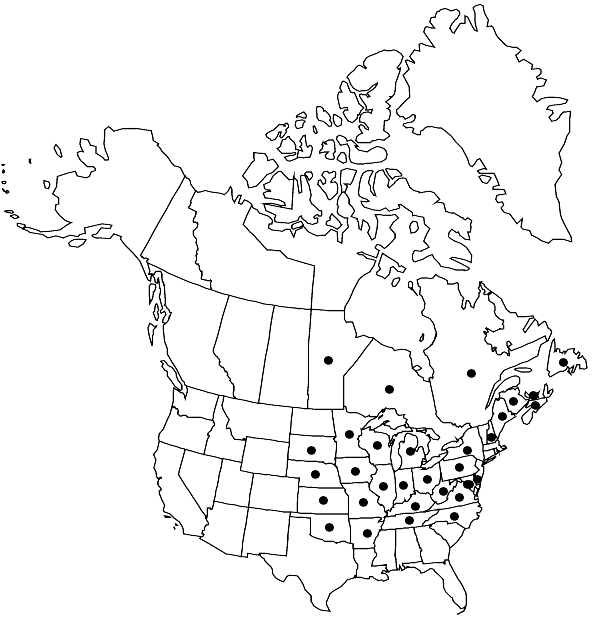Atrichum altecristatum
Trans. Kansas Acad. Sci. 23/24: 284. 1911,.
Plants small to medium sized, light to dark green, brown proximally with age. Stems 1–3 cm. Leaves 2–8 × 0.7–1.5 mm, keeled and concave, rarely almost plane, rather narrowly lanceolate to lingulate, more or less undulate with rows of abaxial teeth on the undulations, the apex acute or sometimes proximal leaves obtuse; costa percurrent or subpercurrent with abaxial teeth near apex; lamellae 4–6(–8), laxly spreading, 4–6 (–9) cells high; median leaf cells 24-28 µm wide, rounded to ± regularly hexagonal, rather thick-walled, strongly collenchymatous with trigones, smooth or occasionally with minute, verrucose or striate papillae mainly on abaxial surface. Sexual condition polygamous, some shoots apparently unisexual males or females, others with both sexes; perigonia inconspicuous, the outer perigonial bracts resembling stem leaves but with a broader base, the inner small, ovate or suborbicular. Seta 1–3 per perichaetium, 1–3.5 cm, erect. Capsule 2–7 × 0.5–0.8 mm, cylindric, usually somewhat curved and inclined, sometimes straight and erect; operculum 2–3 mm. Spores 9–21 µm.
Phenology: Capsules mature spring–fall (Mar–Oct).
Habitat: Soil banks along roads, trails, often on hummocks in clearings in woodlands, open or semishaded conditions
Elevation: usually low elevations
Distribution

Man., N.B., Nfld. and Labr. (Nfld.), N.S., Ont., P.E.I., Que., Ark., Del., D.C., Ill., Ind., Iowa, Kans., Ky., Maine, Md., Mich., Minn., Mo., Nebr., N.H., N.Y., N.C., Ohio, Okla., Pa., S.Dak., Tenn., Va., W.Va., Wis.
Discussion
Atrichum altecristatum is a common and widespread species, particularly in northcentral United States. It is distinguished from A. angustatum by the lamellae 4–6, and 4–6 cells high (against 6–9 lamellae, up to 15 cells high in A. angustatum), and leaf cells 24–28 µm in longest dimension, collenchymatous, with evident trigones (as opposed to cells smaller and subquadrate in A. angustatum, bulging mammillose on the adaxial surface). The difference in sexuality is more difficult to demonstrate, since most plants in a colony may appear female, with only a few shoots bearing a male inflorescence followed by a female inflorescence and sporophyte on the same stem about a centimeter above the male. As a result, the species is monoicous, but functionally dioicous. The taxon known as A. crispum var. molle (Holzinger) Frye evidently belongs here (R. R. Ireland 1969).
Selected References
None.
